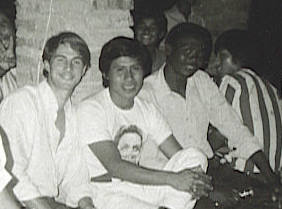Seeking Intimacy with Christ
Our church recently had a college Ministry Celebration Sunday to hear various testimonies from local college students about how the local Wesley Foundation http://www.ungwesley.org/ has deepened their relationship with the Lord. After six or seven students shared their spiritual journey, a startling pattern was revealed. In describing their attraction to the Wesley Foundation a number of the students spoke of discovering intimacy with God for the first time through the college ministry. It struck me that the students had grown up attending various Protestant denominational churches, knew the gospel from the Bible, wanted to be good Christians, and yet shared they had never encountered God intimately until they came to college. Several of the students stated that they had believed in the Lord, but did not have personal relationship with the Lord. This woman is one of the students that shared that day:
Discovering Intimacy with God in Bolivia and a Monastery
Listening to these college students share their testimony of discovering intimacy with God at a later age really struck a chord with me. When I was 21 years old, I spent a year as a volunteer missionary in Yucumo, Bolivia, and it was there working in an environment of Christian Community in Colegio Rio Colorado https://es-la.facebook.com/Colegio-T%C3%A9cnico-Agropecuario-Rio-Colorado-157387770942497/ that I encountered spiritual intimacy with God. Although I had been a Christian since the age of eight, I understood faith as believing certain doctrinal statements about God and God’s saving grace through Jesus. My primary image of God was a distant Judge watching over me and the world. My discovery of spiritual intimacy with God in Christian Community in Bolivia was one of the formative events of my life.
Years later I had another radical encounter with God on a silent prayer retreat at the Monastery of the Holy Spirit in Conyers, Georgia http://trappist.net. I was in a time of silent prayer and meditation when God began to speak to me. I began to reflect on my life and my relationship with God, my wife and my children. I actually began to shed tears, I was so overwhelmed with a sense of clarity about the repentance and healing that needed to take place in my life, the direction God wanted my life to go and the presence of God with me. I was overwhelmed by the sense of God’s love for me and this filled me with peace.
In trying to understand this experience, I discovered that much of the New Testament deals with developing an intimate relationship with God. The Scripture speaks of this intimacy as union with the Lord (1 Corinthians 6:17), abiding in Christ (John 15:4-8), oneness with God (John 17:20-23), living life in the Spirit (Romans 8:9-16) and participating in the divine nature of God (2 Peter 1:3-4). If someone does not have intimacy with God these New Testament teachings are incomprehensible.
How to Encourage Intimacy with God
Having been a pastor for 20 years at various churches, I have noticed a decided lack of intimacy with God in the spiritual lives of many persons inside and outside the churches. There are a number of factors in American culture that contribute to this lack of intimacy with God: apathy, disdain, ignorance and lack of instruction.1 Within the Body of Christ, the lack of intimacy with God in American protestant churches has created a culture where many Christians do not receive instruction and opportunities to encounter God personally and discover the joy of living full spiritual lives.2 I began to pray about things that I could offer in my Church to help people develop intimacy with God. While I could not replicate my Bolivian experience for the entire church, I felt God leading me to offer greater opportunities for people to encounter God intimately within the life of the Church. Would offering people an opportunity to develop a contemplative prayer practice in their lives bring them intimacy with God? What would this look like in our Methodist church setting? I introduced a contemplative prayer practices fifteen months ago at Dahlonega United Methodist Church http://www.dahlonegaumc.org/ and this project analyzes the results by interviewing persons who have participated to see if contemplative prayer helped them develop intimacy with God.
Implementing Contemplative Prayer at Dahlonega UMC
I chose a very specific methodology of beginning with the Staff and then the congregation to implement contemplative prayer practices into our church. Contemplative prayer is unique prayer because it is silent, still prayer which focuses on God and God’s word in order to bring the participant into the presence of God in an intimate way. Some theologians differentiate between meditative prayer (silent prayer guided by scripture) and contemplation (silent prayer focused on God), but throughout Christian history the practice of prayer focused on God and God’s word has been a synchronous practice.3 Biblical instruction and historical practices of contemplative prayer involve both meditative prayer over scripture (Psalm 1:2) and intimate prayer with God in the “inner room” which Jesus’ advocated (Matthew 6:6). The two primary methods I used to help introduce contemplative prayer into the Church were moments of silent prayer and a form of meditating on Scripture called Lectio Divina. Lectio Divina is a form of hearing and praying over the Bible readings in order to hear God speak directly to the hearer’s situation.4 It involves listening to a passage of Scripture read multiple times and allowing God to speak to the hearer’s present moment through the spiritual revelation of a word or phrase within the passage.5 The theology of Lectio Divina is that the many words of the Bible ultimately help us to hear the Word who is God (John 1:1).6
I felt it was wise to begin with the staff as they are the ministers to the rest of the church. I ask each one to pray silently over Scripture or focusing on God during the week in the Sanctuary and afterwards to integrate similar contemplative prayer practices into their various ministries. We added a contemplative prayer moment of 5 minutes of silence into the Sunday morning worship services, began a Wednesday morning prayer service which centered around hearing scripture read followed by 20 minutes of silent prayer, added 30 minute silent prayer time before our college ministry meetings, added silent prayer or Lectio Divina into numerous adult classes and took several group silent prayer retreats to the Monastery of the Holy Spirit. This integrated program created multiple contemplative opportunities for participants to encounter God in prayer or prayerfully hearing Scripture. This student began to pray contemplatively prior to worship:
After one year, I interviewed several persons who participated in each of the programs that we started in the Church. The Staff members shared about personal time of prayer that had become dear to them. Members of the congregation shared about the contemplative moment in the worship service. The regular attenders to the Wednesday morning prayer service shared how it had become a fundamental part of their devotional life and allowed them to both unburden themselves before God in the silence and hear God’s leading in their lives. Participants in the Bible studies shared how hearing Scripture read in Lectio Divina had opened up new understandings of passages to them. Several of the college students and youths shared that they experienced God in much more personal and intimate ways through contemplative prayer; this had opened them up to hearing God for the first time. Two of those persons who participated in the multi-day silent prayer retreats shared of receiving spiritual knowledge of being a child of God that came only through prayer.
Major Findings and their Implications
I was surprised by the depth of passion and the intimate language used by many of the participants. These interviews show that the implemented practices of contemporary prayer were successful in helping the participants develop greater intimacy with God. Several of the interviewed participants spoke of hearing God and discerning God’s voice. Others spoke of discovering new ways of encountering God and having their lives changed because of these encounters. Most strikingly, several of the participants spoke of spiritual union with God taking them to a deeper place in their relationship with God. They spoke of understanding oneness with God or feeling like the bride of Christ. Several of the participants spoke of the practice becoming a central healing part of their relationship with Christ.
I was surprised that more of the Church did not participate in the various offerings. When I began the Morning Prayer Services on Wednesdays, I assumed that it would grow in time through word of mouth. However, after we had been worshiping for one year only about 20-30 persons were actively participating in the service (for a frame of reference we had over 200 in attendance for Ash Wednesday service). Perhaps the morning time knocks out many who have to go to work or school. I have taken eight persons on a contemplative retreat, and the average size of our classes that teach contemplative prayer and Lectio Divina are only about 12-15 persons. These are wonderful events, but our church has many more persons who are not participating. Many persons responding to a survey cited lack of time as the primary reason for lack of prayer in their lives. The survey responses revealed people who long for God, but do not feel they have the time to practice contemplative prayer.
Interestingly, the greatest number of people participating in the contemplative practices to find intimacy with God are those between the ages of fifteen and twenty-five years old. The Wesley Foundation has over forty people praying in silence in the Sanctuary every Wednesday evening prior to their worship. The youth group, which has about fifty young adults from the Church and community, has been very positive about prayer and it has energized their meetings and bible studies. This could be a factor of passion, or it could be a factor that those under the age of 25 have more time on their hands to spend hours in prayer.
What’s Next for this Project?
The findings of this project show that a lack of spiritual intimacy with God within an American Protestant church may be remedied for some people by the introduction of contemplative prayer practices within the life of the church. These findings suggest that offering diverse and multiple opportunities for people of all ages to participate in forms of contemplative prayer will allow many persons within the church body to experience intimacy with God in new ways. The contemplative prayer practices that were offered at Dahlonega United Methodist Church enabled those who participated to encounter God through contemplative prayer, Lectio Divina and contemplative retreats. People encountered God in new ways, developed greater understanding of scripture about intimacy with God and experienced spiritual union with God.
These findings also suggest that many within a church body are either uncomfortable or apathetic about the promise of greater intimacy with God. We must further study the many reasons why people who have faith in a living God do not long for intimacy with God. A future study may perhaps reveal deeper issues of intimacy between Christians and God and one another and its connection to divisiveness in modern life. These findings also suggest that there is an enthusiasm gap for intimacy with God through contemplative practices between those under the age of twenty-five and those who are older. Some of this may be due to time constraints for people with jobs and families. A future study may delve into contemplative practices that can be done while someone is involved in daily life activities.
1 Robert C. Fuller, Spiritual, But Not Religious: Understanding Unchurched America (Oxford: Oxford University Press, 2001).
2 N.T. Wright, Simply Christian: Why Christianity Makes Sense (New York: Harper One, 2006), 17-20.
3 A. Poulain, The Graces of Interior Prayer: A Treatise on Mystical Theology (St. Louis: B. Herder Book Co., 1907), 59.
4 Mariano Magrassi, Praying the Bible: An Introduction to Lectio Divina (Collegeville, MN.: Liturgical Press, 1998), 5.
5 Ibid, 27-28.
6 Michael Casey, Sacred Reading: The Ancient Art of Lectio Divina (Liguori, MO.: Liguori/Triumph, 1995), 36.
Save

We are different religions, but I’m sure everyone who has religious beliefs wants peace for himself.